Travel diary, part 6: Off to the far north: Masoala
Maeva* is an intern at ADES and is currently writing her Master's thesis in Madagascar. She gives us an insight into her experiences.
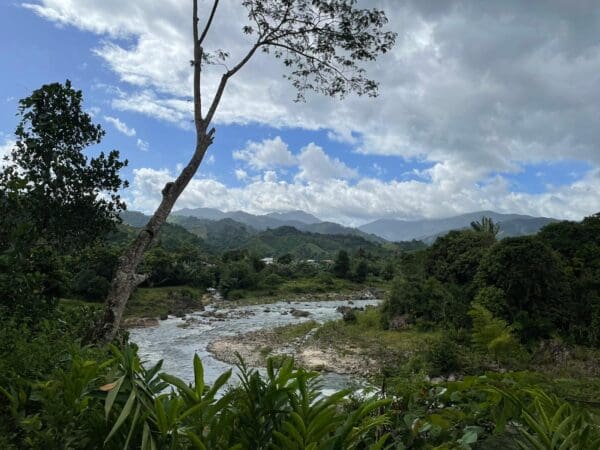
It's now the beginning of May and I won't be leaving again until the end of June. So far, I've been lucky enough to have seen quite a lot with Luc and to have travelled from Toliara to Tana. Now my direction is changing and May is taking me up north. And where better to start than in Maroansetra and Masoala, in the green heart of Madagascar?
But it doesn't really want to start on Monday 6 May after all. Firstly, the notification I received a few weeks ago that the flight had been brought forward and would now depart at 9.00 am instead of 2.00 pm is not correct. And so I spend the next six hours waiting at the airport. Of course, the flight is also delayed, so the six hours turn into seven. But finally we board the plane and after about an hour we fly lower and get ready to land over Maroansetra. We descend through the dark clouds and I see raindrops on the windows. Below me I see a deep green, rice fields, trees and earthy roads. But strangely enough, the plane continues to fly beyond its destination and now we are over the sea. I wonder if maybe the pilot had the wrong angle to land or something, but then the plane suddenly accelerates and we are pushed back into our seats as the plane climbs back above the clouds. There's a 180-degree turn and I can't believe what I already suspect: we're flying back to Tana! For meteorological reasons, our pilot didn't want to land. The next hour passes far too slowly, dragging on incredibly, fuelled by frustration and disappointment, as well as uncertainty as to how and whether I will get to Maroansetra. Not only do I have a reservation there, but Maroansetra is also the starting point for my next chapter and my journey through the north, from Antalaha to Diego Suarez along the north-eastern coast. Maroansetra lies below the large Masoala peninsula, a rainforest and nature reserve, before the built-up roads and towns return. There is currently no road through Masoala. There used to be one, but today there is only a beaten track. Even the motorbikes, which otherwise get through practically everywhere (they are even taken across the rivers in pirogues), can no longer get through here after a certain point. So, with a little help, I was able to organise a five-day trek with a guide and porters that would allow me to cross the Masoala rainforest on foot as far as Antalaha. From there, I would be travelling on bikes again. But in order for me to realise my grand plan, I would have to physically arrive in Maroansetra first! I'll spare you the long wait, the discussions and the perseverance, and cut a little short: our flight was postponed until the next morning, and after the unplanned night in Tana, we finally arrived in Maroansetra the following day around midday. But only after the pilot of this flight had also circled the aerodrome three times!
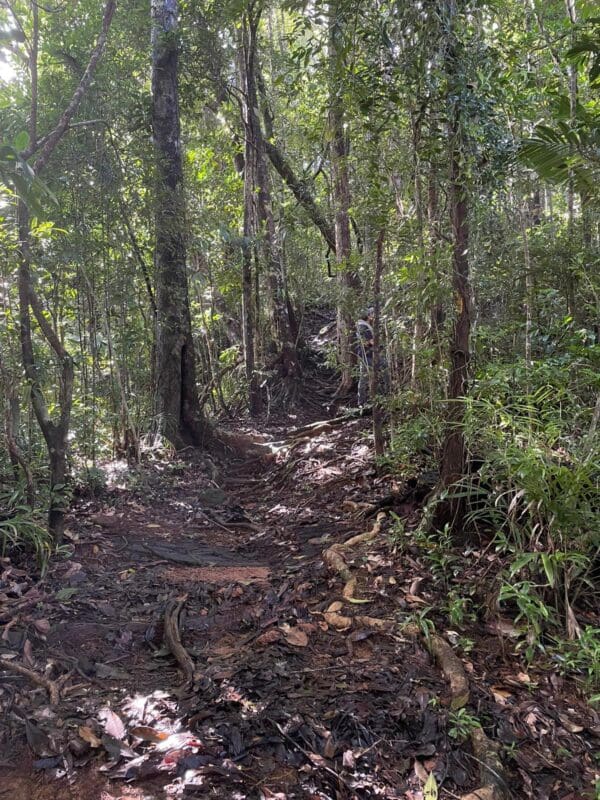
When we finally drive into Maroansetra from the airport to the city via the piste, we are lucky: for the first time in about a month, the sun is shining. And it is breathtakingly beautiful. The small town glows with freshness and colour, the road is still built-up and dry at first, but the closer we get to the centre and the sea, the more paths are actually under water. That's why most of the houses here are on stilts, and yet there are some very funny scenes: Chickens huddled together on a raised ledge as if on an island, children pretending to be in a pirogue on the raised wooden terraces in front of their huts and paddling a world I can't see with a stick, men all sitting together in a bar - and all with their feet ankle-deep in water. It's impossible to get through here dry, so I quickly take off my espadrilles and walk barefoot through the water, which is sometimes as warm as a bathtub, at midday. In the afternoon it suddenly thunders, and less than 10 seconds later it really is pouring down again. Fortunately, I can take shelter as I'm still visiting friends of many years' standing at that very moment. Towards evening, the clouds open up again and we walk back to the hotel almost dry. To my astonishment, I return almost dry-footed.
What has impressed me again and again since my arrival in Mada are the many children here. No matter where you look, there are children everywhere. From babies to teenagers, there is something going on everywhere and it gives a very young, active and lively atmosphere. Carried in swaddling clothes on their mothers' backs, in the arms of their sister or brother, four on a motorbike, six in a tuk-tuk or in a pousse-pousse on the way to school. They lie asleep on the market stalls while their mothers sell vegetables, run after bicycle tyres with sticks, play with glass marbles or lie in their mothers' arms while breastfeeding. It's so normal, so incredibly natural, one of the most natural things there is. And it's so good to see it, to experience it, to be immersed in the authenticity and vitality of life again. I start to ask myself questions about my own children and where I am in my life. Because there is a vibrancy here that is awakening and infectious. It is inviting and allows you to participate or get to know the collective, communal culture that I often perceive here in Mada.

After a night in Maroansetra (pronounced Maruansetsch), we continue by boat to Masoala. We spend another night here (two were planned, thanks to MadaAirlines) before starting the trek, initially by boat and taxi-moto. From today onwards, we are accompanied by Armand, our guide. Armand is not only a legend among the guides here in Mada, he is also a blatant environmental activist and whistleblower. He has worked for various NGOs such as WWF and UNICEF, attended several climate conferences, including one in London, and fought for years against illegal deforestation and the export of rosewood. He even clashed with the government in the process. He grew up in Masoala and knows the rainforest like the back of his hand. It is obvious how much he loves the nature, the animals and the biodiversity here, and it is incredibly impressive how he has been protecting it for years. Armand knows an incredible amount about the people here and he finds every animal. We are out and about with him during the day and later at night too. I never play "I see what you don't see" with him. In general, he always sees what I don't see, even when he points and tries to explain to me where a green chameleon is sitting at the back of the brown tree trunk on the left, between the two lianas.
During our hikes and additional visits through the forest, thanks to him we see the Red Vary lemurs, five different species of chameleon, lots of frogs, a bat, tenrecs, snakes, rare birds, and at night he even finds six different species of lemur, the smallest of which was barely as big as my fist, and even an uroplatus - at night! But apart from all the animals and the incredible biodiversity, it is also beautiful here. The trees seem to drip with life, the earth alternates between ochre-red and a warm brown, there are fern trees up to five metres high (yes, trees - these are no longer shrubs that we hold under the microscope in biology lessons), lianas twist and curl along the trunks or hang between the branches, and huge strong roots form almost small shelters and protrude from the earth. At one point we came across such a large tree, which must have been around 30 metres high, with a wall of roots! Its roots were over two metres high and extended about eight metres wide in both directions of the trunk. The tree formed niches and curves.
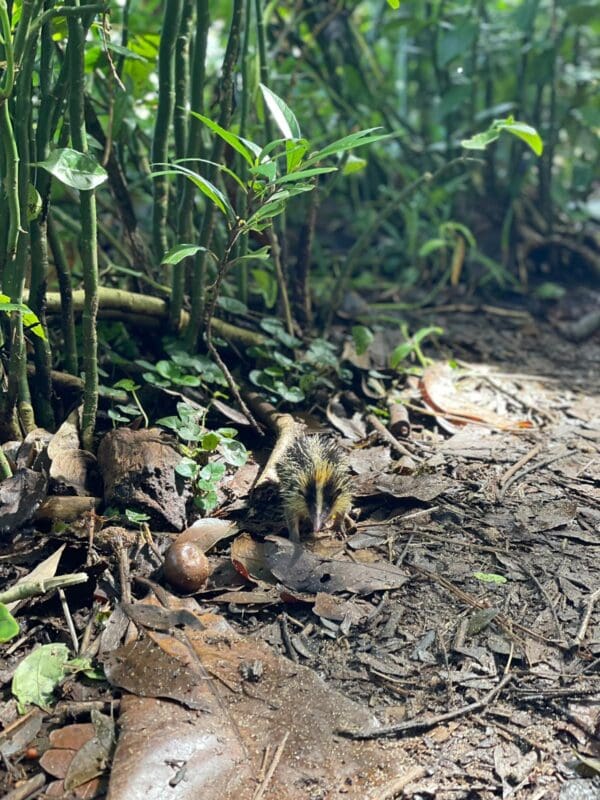
Even later, as we walk further out of the protected national park through the forest, we see countless planted fields with all kinds of tree species: lychee, mango, fruit à pain, cloves, cinnamon and much more. Did you know that cinnamon is made from the bark of trees? I didn't know, and I couldn't believe it when Armand scraped off a bit of bark from the tree in front of me and held it under my nose. Cinnamon has never smelt so good. And that's why "je crois que les plantes du monde entier sont heureuses ici".
At the very beginning, before we officially set off, I made a fundamental mistake: I hadn't paid enough attention to his question and his advice. He had asked me if I had an umbrella with me. I didn't, because balancing through the jungle with an umbrella seemed anything but practical to me, and a rain jacket certainly did the trick. No, it didn't! I would regret it the same day. Because on the day we arrived in Masoala, before we set off the next day, we went for a walk in the forest. As soon as I set foot in the dense greenery, it started to pour, and just as I took my first step out of the forest about 20 minutes later, the sun came out again. I was soaked to the bone. When Armand told us that there is a species of lemur that doesn't drink water, I wondered how that could be. Now everything is clear. Who needs to climb out of a tree to drink water when you're practically drowned from the sky? You couldn't drink if you wanted to. So remember, you always go into the rainforest with an umbrella. Makes sense, actually. After all, it's called a "rainforest". It also looks pretty funny, because for the next five days I followed a black umbrella bobbing up and down in front of me across the Masoala National Park.
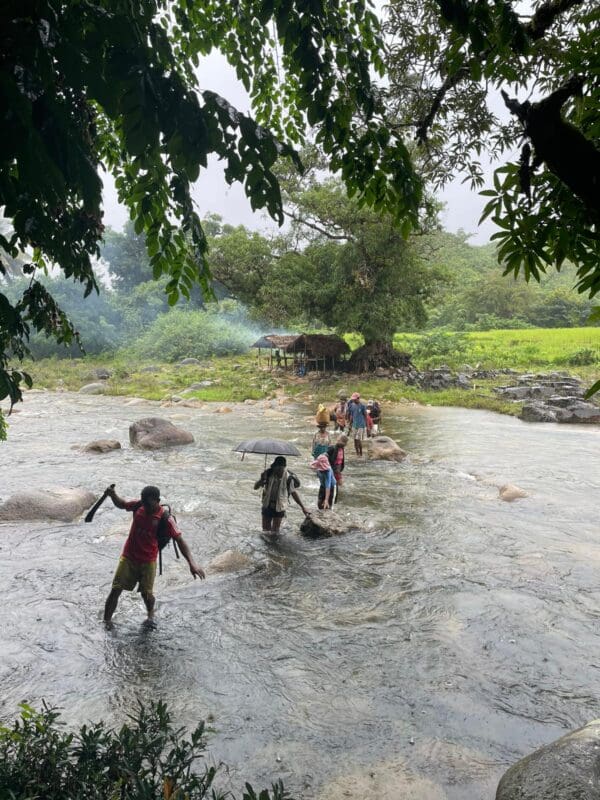
During our trek, Arman says, "Mora Mora", so we take our time, and as we walk he tells us about the people who live here, about rice cultivation, the big differences between the various types of rice, about all the different trees and plants that are grown, how to recognise good vanilla pods, and what is worthwhile for the farmers, and where they would have been better off not clearing the trees for rice, but leaving the rosewood instead. He seems like the ideal link between the NGO world and the desire to protect the rainforest and the local farmers who use it to survive.
In general, the encounters we have on our path are very special. But in order to really understand them, it is important to know the firmness of our path. It is mud. Practically only mud. It rains up to 6 times a day, it's always wet, sometimes we cross rivers and are up to our chests in water, and then we go straight on through the mud. When I was still ignorant, at the beginning, I took my shoes off or even walked barefoot. I was soon proved wrong. From then on, I wore my socks and trainers all the time and enjoyed the cool water when we waded through the streams from the mud, even if sand did get deposited in my shoes. We also made faster progress that way. However, my trainers were not particularly beneficial as I had wrinkly feet every evening and had to slip back into my still wet shoes the next morning. I had never missed my previous Velcro sandals so much, and envied Armand his modern Kroks, as well as Nassan (our porter) his plastic water sandals. Nevertheless, we always ran at a good pace and made good progress, but were always, and I do mean always, overtaken by everyone else. And my mouth was always hanging open. Some of them were guys carrying petrol canisters suspended from bamboo tubes - about 40 litres per canister. Or it was women carrying a huge bucket of dried fish, coal, vegetables or other luggage on their heads. There were men walking back to their village from cutting wood in the forest, or whatever looked great: Women carrying a handbag on their cook and a machete in their hand. Also impressive was the young couple who were on their way to Sambava (even further than us), taking it in turns to carry a piece of luggage and their baby. A small child simply being carried through the middle of the jungle. So absurd, and so unbelievable! And everyone was always barefoot and travelling at a hellish pace. Only when it got really muddy did they have to walk a little more carefully. Then they only overtook me twice and not three times as fast.
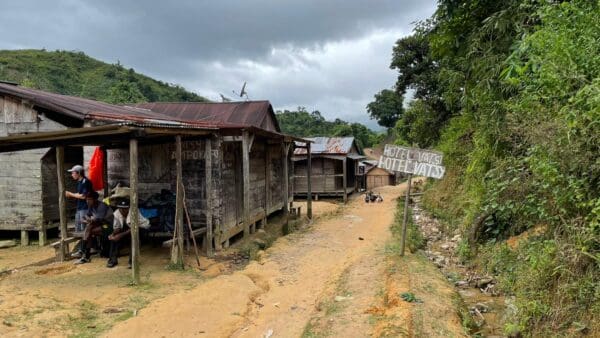
We caused quite a stir in the villages we passed through, as Vazahs are probably not seen too often here. The children always greeted us with a mixture of great excitement, shyness and slight uncertainty. The mood also changed from village to village. Sometimes I found it almost a little scary, especially when a Zébu skull suddenly stood impaled in front of a hut. Sometimes villages were characterised by warmth and laughter and bustling activity. With women fanning the rice, selling bananas, while children played all around. On the way, we stayed in the small hotels in the villages, and even though it was always damp and my clothes never wanted to dry completely, I was almost always welcomed by a cosy bed. Our cook, who accompanied us, was about my age and she cooked for us like a king. We often ate together with Armand and the porters, and what they could eat! While I had either bread with a spread or pancakes for breakfast, the Madagascans would shovel in a huge plate of rice - and then another. You didn't eat without rice here, it's such a habit that even if you had eaten something else and had eaten enough, you would prepare another plate of rice at home. So I watched in amazement and with a grin as the others ate, when they started to eat hungrily like me, but ate three times as much, even though we were probably about the same size and weight.
Yes, that's what those days were like. On the penultimate day we walk for 9.5 hours, and on the morning of the last day we set off at 6am and manage the last 15 kilometres through the mud in 3.5 hours. From this village a boat awaits us, and I am more than grateful to sit in the narrow, long, steel canoe with the other passengers and roast in the sun as we chug the last stretch down the river to Antalaha. Actually, we should have been travelling by taxi-moto again from here. But the road was now so muddy that we were almost up to our chests in mud. And so we gradually leave the forest behind us, and at some point after about 4 hours of river travel I see a long bridge in front of us and the sea behind it.
* Name changed

